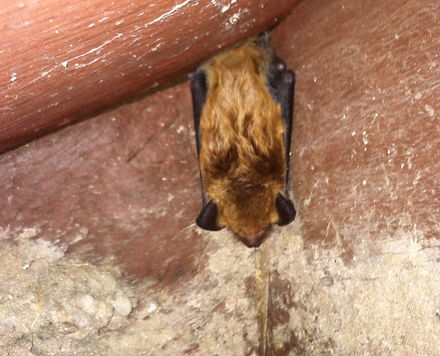Bat Info

Spring Bats
When warm temperatures start and bugs begin to fly, out come the bats. Spring is a great time to exclude the bat colony from your attic. Juvenile bat pups are born in the last few weeks of May to the first weeks of June, and it is very important that the bat exclusion is completed before this point.
Summer Bats
During summer months bats are most active due to warm temperatures and large insect populations. The juvenile pups are learning to fly and are generally ready by the last weeks of July to the first weeks of August. If it is determined that you have a maternal colony with pups, we will have to wait until August to perform your exclusion. If it is male colony, the exclusion can be done immediately. Bats are a protected mammal and very important to our environment, they are always safely relocated.
Fall Bats
During fall months, all juvenile bats are flying making this a great time for maternal exclusions. Fall temperatures do fluctuate, but bats will fly until the the frost hits and diminishes their insect food source. It is good to keep the one-way bat doors in tact until late spring to ensure that bats, who may be hibernating in the insulation of your attic during fall and winter, are actually excluded.
Winter Bats
Winter can be the best time to start the exclusion process. If your roof is clear and dry, we can perform all necessary repairs. The one-way doors will stay up until late spring to make sure dormant bats have left. Bats have to stay in temperatures above 40 degrees to survive, so you may hear scratching in walls and ceilings during these cold months as they try and stay warm. Bats may end up in basement or living quarters as they network deeper into insulation to survive.

Rabies
Rabies is a preventable viral disease of mammals most often transmitted through the bite of a rabid animal. The vast majority of rabies cases reported to the Centers for Disease Control each year occur in wild animals such as; raccoon, skunks, bats and foxes. The rabies virus infects the central nervous system, ultimately causing disease in the brain and death. The principle rabies hosts today are wild carnivores and bats. The number of rabies related human deaths has declined greatly and there are very few every year. Our technicians are equipped with tools to safely remove the bats from your home, you should not attempt to remove a bat yourself as it is not known whether or not they are rabid. If you suspect you have been bitten, you should seek immediate medical care.

Bat Bugs
These are blood-sucking insect parasites that feed primarily on the blood of bats. Bat bugs are closely related to bed bugs, in fact they are so similar that they are often mistaken for bed bugs. Microscopic examination is needed to distinguish them. Bat bugs will bite humans if given the opportunity, making it very important to get an exclusion if you have bats in your home to eliminate the primary hosts.

White-Nose Syndrome
Is an emerging disease in North American bats which has been associated with at least 5.7 million bat deaths. The condition is named for a distinctive white fungal growth around the muzzles and on the wings of hibernating bats and was first identified in 2006. It has rapidly spread. The fungus has been found in caves and mines of 25 states throughout the Northeastern US, and as far north as five Canadian provinces. No obvious treatment or means of preventing transmission is known, and some species have declined almost 90% within five years of the disease reaching a site. The common little brown bat has suffered a major population collapse in the northeastern US. The Forest Service has estimated that the die-off from white-nose syndrome will mean that an estimated 2.4 million pounds of insects will go uneaten and become a burden to farmers, possibly leading to crop damage and other economic impacts. It's also estimated that bats save farmers about 3 billion dollars annually in pest control services. In addition, numerous bat species provide a crucial pollination and seed dispersal service for plants.

